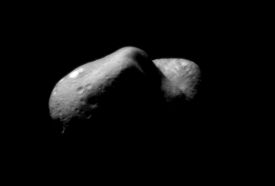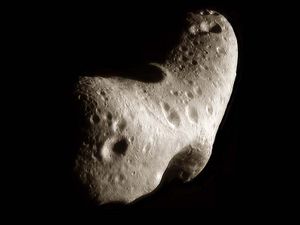433 Eros

View from one end of Eros across the gouge on its side towards the opposite end.
|
|
|
Discovery
|
|
|---|---|
| Discovered by | Carl Gustav Witt |
| Discovery date | August 13, 1898 |
|
Designations
|
|
| Named after | Eros |
| Alternate name(s) | 1898 DQ; 1956 PC |
| Minor planet category |
Amor, Mars-crosser asteroid |
| Adjective | Erotian |
| Epoch October 22, 2004 (JD 2453300.5) | |
| Aphelion | 266.762 Gm (1.783 AU) |
| Perihelion | 169.548 Gm (1.133 AU) |
| Semi-major axis | 218.155 Gm (1.458 AU) |
| Eccentricity | 0.223 |
| Orbital period | 643.219 d (1.76 a) |
| Average orbital speed | 24.36 km/s |
| Mean anomaly | 320.215° |
| Inclination | 10.829° |
| Longitude of ascending node | 304.401° |
| Argument of perihelion | 178.664° |
|
Physical characteristics
|
|
| Dimensions | 34.4×11.2×11.2 km[1][2] 16.84 km[1] |
| Mass | 6.69 × 1015 kg[2] |
| Mean density | 2.67±0.03 g/cm³[1][2] |
| Equatorial surface gravity | 0.0059 m/s² |
| Escape velocity | 0.0103 km/s |
| Rotation period | 0.2194 d (5 h 16 min) |
| Albedo | 0.25[1] |
| Temperature | ~227 K |
| Spectral type | S[1] |
| Apparent magnitude | +7.0[3] to +15 |
| Absolute magnitude (H) | 11.16[1] |
433 Eros (pronounced /ˈɪərɒs/ IRR-os, or as Greek Ἔρως) is the first discovered near-Earth asteroid, named after the Greek god of love, Eros. It is an S-type asteroid approximately 34.4×11.2×11.2 km in size, the second-largest near-Earth asteroid (NEA) after 1036 Ganymed, belonging to the Amors. It is a Mars-crosser asteroid and was the first that was known to come within the orbit of Mars. Eros is one of the few NEAs with a maximum diameter greater than 10 km. It is believed to be larger than the impactor that created Chicxulub Crater in the Yucatán, which has been linked to the extinction of the dinosaurs.[4]
Eros was visited by the NEAR Shoemaker probe, which orbited it, taking extensive photographs of its surface, and, on February 12, 2001, at the end of its mission, landed on the asteroid's surface using its maneuvering jets.
Objects in such an orbit can exist for only a few hundred million years before the orbit is perturbed by gravitational interactions. Simulations suggest that Eros may evolve into an Earth-crosser within 2 million years.[5]
The rarely used adjectival form of the name Eros is Erotian (pronounced /ɪˈroʊʃən/).
Contents |
Physical characteristics

Surface gravity depends on the distance from a spot on the surface to the center of a body's mass. The Erotian surface gravity varies greatly, since Eros is not a sphere but an elongated peanut-shaped (or potato- or shoe-shaped) object. The daytime temperature on Eros can reach about 100 °C at perihelion. Nighttime measurements fall near -150 °C. Eros's density is 2,400 kg/m3, about the same as the density of Earth's crust. It rotates once every 5.27 hours.
NEAR scientists have found that most of the larger rocks strewn across Eros were ejected from a single crater in a meteor collision approximately 1 billion years ago. This impact may also be responsible for the 40 percent of the Erotian surface that is devoid of craters smaller than 0.5 kilometers across. It was originally thought that the debris thrown up by the collision filled in the smaller craters. An analysis of crater densities over the surface indicates that the areas with lower crater density are within 9 kilometers of the impact point. Some of the lower density areas were found on the opposite side of the asteroid but still within 9 kilometers.[6]
It is theorized that seismic shockwaves propagated through the asteroid, shaking smaller craters into rubble. Since Eros is irregularly shaped, a 9-kilometer straight line through the asteroid can reach locations that would be further away if travelling across the surface, thus leading to the uneven pattern of crater density on the surface.[6]
History

As one of the larger near-Earth asteroids (NEAs), Eros has played a significant role in history. It was discovered on the same night (13 August 1898) by Gustav Witt in Berlin and Auguste Charlois at Nice.[7] Witt was taking a 2-hour exposure of Beta Aquarii to secure astrometric positions of asteroid 185 Eunike.[8]
During the opposition of 1900–1901, a worldwide program was launched to make parallax measurements of the asteroid to determine the solar parallax (or distance to the sun), with the results published in 1910 by Arthur Hinks of Cambridge.[9] A similar program was then carried out, during a closer approach, in 1930–1931 by Harold Spencer Jones.[10] The value obtained by this program was considered definitive until 1968, when greater faith was placed in radar and dynamical parallax methods.
Eros was one of the first asteroids to be visited by a spacecraft, and the first to be orbited and soft-landed on. NASA spacecraft NEAR Shoemaker entered orbit around Eros in 2000, and came to rest on its surface in 2001.
Visibility from Earth
On January 31, 2012, Eros is expected to pass Earth at 0.179 astronomical units (16.6 million miles), about 70 times the distance to the moon, with a visual magnitude of +8.1.[11] During rare oppositions, every 81 years, such as in 1975 and 2056, Eros can reach a magnitude of +7.0,[3] which is brighter than Neptune and brighter than any main-belt asteroid except 4 Vesta and, rarely, 2 Pallas and 7 Iris. Under this condition, the asteroid actually appears to stop, but unlike the normal condition for a body in heliocentric conjunction with the Earth, it never appears to be retrograde. Its synodic period of over 846 earth days is among the largest of any body in the Solar System.
Legal controversy
In an experimental legal case, Eros was claimed as property by Gregory W. Nemitz of OrbDev. According to the Homestead principle, Nemitz argued that he had the right to claim ownership of any celestial body that he made use of; he claimed he had designated Eros a spacecraft parking facility and wished to charge NASA a parking and storage fee of twenty cents per year for NEAR Shoemaker. Nemitz's case was dismissed and an appeal denied.[12]
See also
- Eros in fiction
- List of geological features on 433 Eros
Further reading
- Clark, C. S.; Clark, P. E (March 13–17, 2006). "Using Boundary-based Mapping Projections to Reveal Patterns in Depositional and Erosional Features on 433 Eros". 37th Annual Lunar and Planetary Science Conference. http://adsabs.harvard.edu/abs/2006LPI....37.1189C.
- Riner, M. A.; et al. (November 2008). "Global survey of color variations on 433 Eros: Implications for regolith processes and asteroid environments". Icarus 198 (1): 67–76. doi:10.1016/j.icarus.2008.07.007.
References and notes
- ↑ 1.0 1.1 1.2 1.3 1.4 1.5 1.6 "JPL Small-Body Database Browser: 433 Eros (1898 DQ)". 2008-02-16 last obs. http://ssd.jpl.nasa.gov/sbdb.cgi?sstr=433. Retrieved 2008-12-11.
- ↑ 2.0 2.1 2.2 Jim Baer (2008). "Recent Asteroid Mass Determinations". Personal Website. http://home.earthlink.net/~jimbaer1/astmass.txt. Retrieved 2008-12-11.
- ↑ 3.0 3.1 "NEODys (433) Eros Ephemerides for 2137". Department of Mathematics, University of Pisa, Italy. http://newton.dm.unipi.it/neodys/index.php?pc=1.1.3.1&n=433&oc=500&y0=2137&m0=1&d0=24&h0=0&mi0=0&y1=2137&m1=1&d1=25&h1=0&mi1=0&ti=1.0&tiu=days. Retrieved 2010-06-27.
- ↑ Dividing the mass of 433 Eros by its density gives a volume of 3000 km3, while the estimated 5 km radius of the (assumed spherical) Chicxulub Crater impactor yields a volume of only about 520 km3.
- ↑ Michel P. et al. The orbital evolution of the asteroid Eros and implications for collision with the Earth, Nature
- ↑ 6.0 6.1 Thomas PC, Robinson MS (1970). "Seismic resurfacing by a single impact on the asteroid 433 Eros". Nature 436 (7049): 366–369. doi:10.1038/nature03855. PMID 16034412. PMID 16034412
- ↑ Scholl, Hans; Schmadel, Lutz D. (2002). "Discovery Circumstances of the First Near-Earth Asteroid (433) Eros". Acta Historica Astronomiae 15: 210–220.
- ↑ Donald K. Yeomans. Asteroid 433 Eros: The Target Body of the NEAR Mission , Jet Propulsion Laboratory/California Institute of Technology.
- ↑ Hinks, Arthur R. (1909). "Solar Parallax Papers No. 7: The General Solution from the Photographic Right Ascensions of Eros, at the Opposition of 1900". Month. Not. Roy. Astron. Soc. 69 (7): 544–67. http://articles.adsabs.harvard.edu/cgi-bin/nph-iarticle_query?1909MNRAS..69..544H&data_type=PDF_HIGH&whole_paper=YES&type=PRINTER&filetype=.pdf..
- ↑ Jones, H. Spencer (1941). "The Solar Parallax and the Mass of the Moon from Observations of Eros at the Opposition of 1931". Mem. Roy. Astron. Soc. 66: 11–66..
- ↑ "AstDys (433) Eros Ephemerides for 2012". Department of Mathematics, University of Pisa, Italy. http://hamilton.dm.unipi.it/astdys/index.php?pc=1.1.3.1&n=433&oc=500&y0=2012&m0=1&d0=28&h0=0&mi0=0&y1=2012&m1=2&d1=10&h1=0&mi1=0&ti=1.0&tiu=days. Retrieved 2010-06-27.
- ↑ The Eros Project
External links
- NEAR Shoemaker spacecraft
- NEAR image of the day archive
- Movie: NEAR Shoemaker spacecraft landing
- The Eros Project (OrbDev's attempts at litigation over their property claim)
- 3D VRML 433 Eros Model
- NASA JPL Small-Body Database Browser on 433 Eros
- NEODys (saved output file from 2007) showing distance and magnitude Ephemerides for Eros during rare oppositions
- The Chicxulub Debate In relation to the K-T extinction.
- Dearborn Observatory Records, Northwestern University Archives, Evanston, Illinois Notations as to historical archived work on asteroid 433 Eros.
|
|||||
|
||||||||